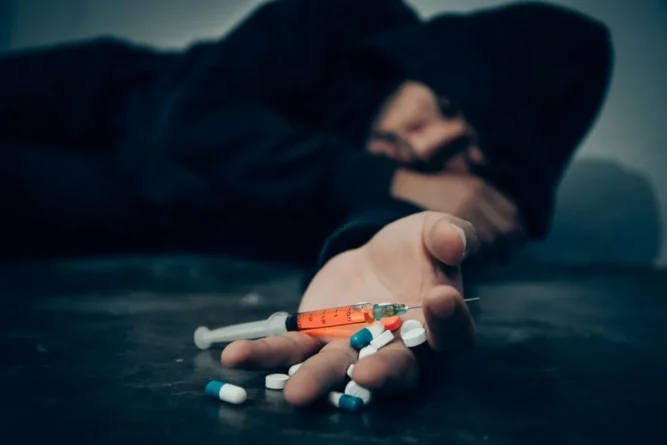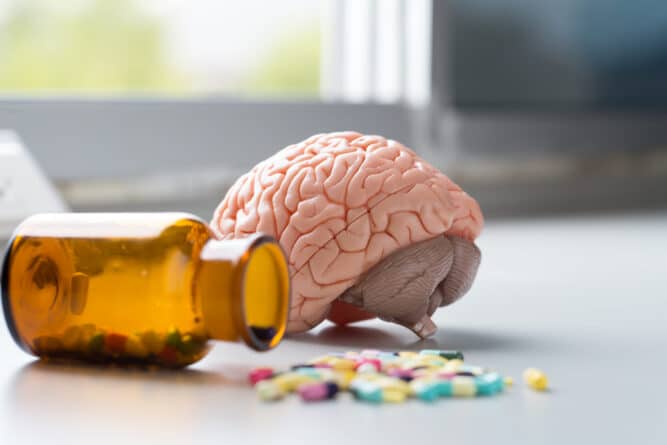
In the United States of America, drug addiction is a problem that affects individuals, families and entire communities. But within this complex problem lies hope for transformation, redemption, and a path to a brighter future. Read today in USA.ONE magazine:
How the States are fighting drug addiction
What progress has been made and what challenges are they facing?
The problem of drug addiction in the USA
Drug addiction is one of the most serious problems facing the United States. This has devastating consequences for individuals, families and society as a whole. Washington faces enormous challenges in finding effective solutions to this problem.
According to the National Institute on Drug Abuse, about 10% of the American population has a history of drug use. Drugs such as opioids, cocaine, methamphetamine and marijuana have a devastating impact on the nation's health and well-being.
The opioid crisis is one of the most serious aspects of drug addiction in the United States. Many people are dependent on medications such as oxycodone and fentanyl, which are often prescribed to relieve pain. This is leading to a significant increase in opioid overdoses and deaths.
In addition, drugs often affect the lives and health of young people. Problems of drug addiction affect education, health care, families and the social structure of the country.
Causes and consequences of drug addiction 
 photo: mountainside.com
photo: mountainside.com
Drug addiction is a serious problem that is faced not only by the United States, but also by many other countries around the world. Understanding the causes and consequences of this addiction is an important step in developing effective strategies to treat and prevent this problem.
The causes of drug addiction in the United States can be varied and complex, including social, economic, and psychological factors. For example:
- Lack of education about the dangers of drugs: Lack of information about the dangers of drugs can lead to their underestimation and use without adequate understanding of the consequences.
- Family problems: Family breakdowns, lack of support and unstable family situations can increase the risk of drug addiction.
- Environmental pressure: An environment in which drugs are considered the norm or even prestige can drive young people into drug use
- Stress and psychological problems: People may turn to drugs as a coping mechanism for stress, anxiety, or depression.
- Easy access to drugs: The uncontrolled distribution of drugs can encourage drug use.
Consequences of drug addiction:
- Health: The health consequences of drug addiction can be devastating, including physical and psychological problems, overdoses, and organ dysfunction.
- Crime: Drug addiction can be associated with criminal behavior such as theft, robbery and drug dealing.
- Destruction of families: Drug addiction can destroy families and personal relationships.
- Social isolation: Drug addiction can lead to social isolation and alienation from society.
- Economic problems: Drug addiction can lead to job loss, financial hardship and poverty.
- Increased risk of transmission of infectious diseases : Drug addiction may be associated with an increased risk of transmission of infectious diseases through injection use.
- Overloading the healthcare system: Drug addiction can burden the healthcare system due to referrals for treatment and rehabilitation.
Understanding these causes and consequences of drug addiction allows society to develop more effective drug prevention, treatment, and demand reduction measures. A combination of prevention efforts, education, access to quality health care and community support for people suffering from drug addiction goes a long way to combating this problem in the States.
Drug addiction statistics in the USA 
 photo: thedawnrehab.com
photo: thedawnrehab.com
Drug addiction is a serious problem in the United States, and its impact on society and individual citizens cannot be underestimated. According to recent studies, more than 20 million Americans suffer from drug addiction. This number covers a variety of substances, including opioids, cocaine, methamphetamine, marijuana and others.
More than 2 million people are addicted to opioids, including legal opioid medications and illegal substances such as fentanyl. Over the past decades, the use and illicit trade of opioids has become unprecedented. Strong synthetic opioids, including fentanyl, have played a major role in this number. Methamphetamine use was also increasing, and the drug was often mixed with opioids, which could increase health risks.
Overdose deaths have become one of the leading causes of death in the United States. In 2019, drug deaths topped 70,000, a new record. According to the Centers for Disease Control and Prevention (CDC), there were already more than 93,000 drug-related deaths in 2020.
Teen drug addiction is also a serious problem in the United States, and it has a negative impact on the younger generation, their families and society as a whole. Here are some key aspects of teen drug addiction in the United States:
- Prevalence: Some drugs, such as marijuana, alcohol, nicotine, synthetic cannabinoids, methamphetamine, and opioids, remain common among teens.
- Causes: Teens may begin using drugs for a variety of reasons, including resistance to social expectations, desire trying new things, environmental pressure, the desire for self-affirmation or relief from stress and anxiety.
- Consequences: Teen drug addiction can lead to a number of negative consequences, such as poorer physical and mental health, behavioral and academic problems, disruption of relationships with family and friends, and an increased risk of becoming involved in crime.
- Opioid Crisis: Teens are also at risk of becoming dangerously dependent on opioid drugs, which may be prescribed by doctors to relieve pain or obtained illegally.
Progress in solving the problem of drug addiction in the USA 
 photo: mountainside.com
photo: mountainside.com
In In the United States, the drug addiction problem is a serious public health and social challenge. Drugs such as opiates (including powerful painkillers), methamphetamine, cocaine and marijuana continue to cause serious problems in society.
The most common strategies to combat drug addiction in the United States include:
- Prevention: Promoting education about the dangers of drugs and early prevention to prevent the onset of use.
- Hope and healing. These are two words that have become central to the fight against drug addiction in the United States. While the problem remains acute and complex, the United States is making significant progress in finding solutions.
- Understanding the problem. An important aspect in solving the problem of drug addiction is a deep understanding of its causes and consequences. The medical community and government in the United States are increasingly interested in research and data analysis to understand how drug addiction affects society and how effective treatment and prevention methods can be found.
- Raise awareness. Public awareness and education also play a critical role in the fight against drug addiction. Awareness and education campaigns are conducted on a variety of platforms to raise awareness of the problem and highlight the resources and support available to those suffering from drug addiction.
- Treatment and Recovery: Developing and expanding treatment programs for drug addicts, including medical, psychological and social approaches.
- Harm reduction: Implement needle and drug exchange programs to prevent transmission of infections and reduce harm for drug users.
- Drug interdiction: Expanding efforts to apprehend and prosecute drug traffickers and their suppliers.
- Medicine-assisted treatment: Use of opioid agonists, such as methadone and buprenorphine, to replace potent opioids in drug addicts.
- Community Collaboration: Supporting local programs and initiatives to engage the community in addressing drug addiction.
Significant resources and efforts are devoted to solving the problem of drug addiction in the United States. However, the complexity of this problem and its connection with other social and economic aspects make achieving full success a long and difficult process.
Drug addiction treatment models in the United States 
 photo: livefreerecoverynh.com
photo: livefreerecoverynh.com
In the United States, drug addiction is a problem that requires immediate attention and effective solutions. To manage this addiction and help those who need medication help, several addiction treatment models have been developed, which are usually combined to achieve the best results. The choice of method depends on the type of drug, the degree of dependence, the health of the patient and his individual needs.
The following are some of the most common drug addiction treatment methods in the United States:
- Drug-assisted treatment (medication-assisted treatment): The use of certain medications, such as methadone, buprenorphine, naltrexone, and others, that help reduce withdrawal symptoms, reduce the desire to use drugs, and help restore normal brain function. This may be part of an opioid substitution program (MMT, MAT) or other medication-assisted approaches.
- Psychological Therapy: Uses various forms of therapy, such as cognitive behavioral therapy (CBT), psychoanalysis, individual or group psychotherapy, to help patients change their thinking and behavior, learn to manage stress, and avoid situations that may trigger drug use.
- Inpatient treatment (rehabilitation): Some patients require treatment in specialized medical facilities or clinics for intensive support and supervision during the process of quitting drugs and beginning recovery.
- Community support: Participation in support groups, such as Narcotics Anonymous (AA) or Narcotics Anonymous (NA), where patients share their experiences and exchange support.
- Psychiatric Treatment: Patients with drug addiction may often have co-occurring mental health disorders , such as depression, anxiety or post-traumatic stress disorder (PTSD). Treatment of such co-occurring disorders may also be an important part of the overall treatment program.
- Drug-assisted treatment for specific drugs: For example, to treat alcohol addiction, drugs such as disulfiram and naltrexone may be used to reduce the desire to drink alcohol.
Drug addiction treatment in the United States is usually individualized for each patient, taking into account his unique circumstances and needs. Patients can receive help from medical professionals, psychotherapists and support groups to achieve long-term remission and recovery from drug addiction.
Discoveries in medicine for the treatment of drug addiction 
 photo: cloudfront.net
photo: cloudfront.net
In the last decade, medicine has made significant discoveries in the field of drug addiction treatment. New methods and approaches offer hope and the possibility of healing for millions of people suffering from this debilitating problem. In this section, we will look at some of the most promising techniques that help fight drug addiction and promote patient recovery.
- Use of New Drug Therapies: Doctors and researchers are working to develop new drugs to treat drug addiction and improve existing ones methods. For example, the potential of new drugs to treat addiction to methamphetamine and cocaine is being explored.
- Innovations in drug support: Combinations of different drug approaches and dosages may provide effective treatment for specific subtypes of drug addiction.
- Vaccine development: Research into vaccines against certain drugs of abuse, such as cocaine or nicotine, may provide new treatments , blocking the effect of drugs in the body.
- Telemedicine and digital tools: The introduction of telemedicine and mobile applications can help deliver effective drug addiction treatments, especially in remote areas, as well as provide ongoing support to patients.
- Genetic research: Some studies have linked genetic factors to developmental susceptibility drug addiction. This understanding can help guide personalized treatment and addiction prevention approaches.
- Applying Artificial Intelligence: Artificial intelligence can be used to analyze data and develop personalized addiction treatments based on each patient's unique characteristics.
- Development and dissemination of harm reduction programs: The harm reduction approach is being actively developed to provide a safe environment for drug users, reduce the transmission of infections and overdose deaths.
Drug addiction treatment strategies are constantly evolving, and researchers, health professionals and Health organizations are actively working to develop more effective and innovative methods to combat this serious public health problem.
Problems and challenges in solving the problem of drug addiction in the USA 
 photo: brightviewhealth.com
photo: brightviewhealth.com
Drug addiction is a serious problem facing many countries, including the United States. In the fight against drug addiction, national and local organizations have developed various strategies and programs. However, despite this, a number of problems and challenges remain that require continued attention and improvement.
- Opioid Epidemic: The epidemic of opioid use, including powerful painkillers, has become one of the most serious drug addiction problems in the United States. Opioid abuse has led to a significant increase in overdose deaths and has become a challenge to society and the healthcare system.
- Synthetic Drugs: The emergence of new synthetic drugs such as methamphetamine and fentanyl has become a major problem. They are highly potent and can be lethal even in small doses.
- Uneven access to treatment: Despite efforts to expand treatment programs and reduce harm, some communities and regions still face a lack of access to adequate medical care and rehabilitation for drug addicts.
- Related Problems: Drug addiction is associated with a number of related problems, such as the spread of infections (such as HIV and hepatitis C), crime, homelessness, and family breakdown.
- Stigmatization: Stigma associated with drug addiction may discourage patients from seeking treatment for help and receive support.
- Funding and Resources: Substance abuse treatment requires significant financial resources to provide effective care and support to patients. Many drug addiction prevention and treatment programs face a lack of funds, limiting their effectiveness and ability to help many people in need.
- Barriers to the intersection of health and justice systems: Some drug addicts face difficulties in obtaining help due to tensions between health and justice systems.
- Lack of awareness: Some people do not understand the seriousness of the problem of drug addiction and its consequences, which can hinder the implementation of effective programs and initiatives.
- Social Causes: Drug addiction is often the result of social problems such as unemployment, poverty and lack of access to education and healthcare. Solving the problem of drug addiction requires a comprehensive approach that includes eliminating social inequalities and creating opportunities for a better life.
Addressing the problem of drug addiction requires an integrated and comprehensive approach, including prevention, treatment, rehabilitation, community collaboration and education. This is a complex task that requires concerted efforts on the part of government, health professionals, society and other stakeholders.
The role of family and society in addressing the problem of drug addiction
Family and community play an important role in combating the drug addiction problem in the United States. While medical experts and government agencies develop treatment programs and provide information about the dangers of drugs, the role of family and society is to support and include people suffering from drug addiction in social networks where they can get help and support.
To sum up the high level of education in this area, Charities, religious groups, local communities and other social organizations play a key role in providing educational programs, support against drug addiction and the destructive consequences. They conduct information campaigns, organize public events, and offer advice and support to those who need help.
In addition to providing financial and moral support, families and communities can also play an important role in creating positive and a supportive environment that promotes recovery and healing for addicts. Helping drug addicts integrate into society after treatment and rehabilitation can reduce the risk of relapse and ensure sustainable adaptation to normal life.
Like this article? Share it with your friends on social networks, and in the comments tell us how you see the solution to the problem of drug addiction in the States?